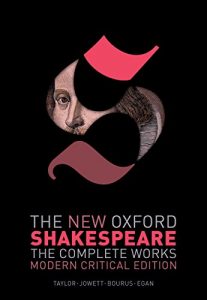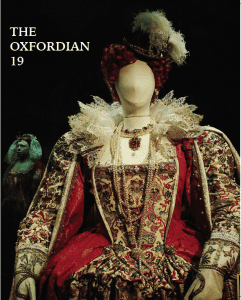After evaluating the new edition of Shakespeare’s works by Oxford University Press (OUP), three scholars contend that the editors have failed to prove their hypothesis that Shakespeare worked with 11 co-authors throughout his career. Their review has been published in the 19th edition of the peer-reviewed journal, The Oxfordian, and can be read in full here.

“The central claim by Oxford University Press editors — that William Shakespeare had 11 co-authors for 17 of the plays in the canon — has been refuted in this critical study,” said journal contributor Gary Goldstein. “This radical new edition of the Bard [pictured, left] is based mostly on stylometric studies conducted by computer engineers who measured the relative frequency of function words such as ‘of’, ‘by’ and ‘from’ in Elizabethan and Jacobean plays to determine an author’s identity.”
The 2016 OUP edition also attempts to significantly expand the canon of plays attributed to Shakespeare. For centuries, the consensus among literary scholars was that the Bard wrote 37 plays (the 36 in the First Folio plus Pericles), and co-authored The Two Noble Kinsmen with John Fletcher. The new OUP edition seeks to increase that number to 44, adding such allegedly co-authored plays as Edward III, Arden of Faversham, The History of Cardenio, Sejanus, The Spanish Tragedy, and Sir Thomas More. The OUP edition’s lead general editor is Gary Taylor, Professor of English at Florida State University.
Focusing on the stylometric research at U. of Pennsylvania, the review’s authors emphasize that one defect of the OUP’s analysis, “which the lead author (Segarra) admits to but perhaps doesn’t fully recognize, exists at the core of their argument: their study is incomplete. They claim that the author of Henry VI could only be Christopher Marlowe or George Peele; then they say it is not possible to compare Marlowe with Peele. According to Segarra, ‘If you had to pick two [candidates], then you would go for Marlowe and Peele, but in the latter’s case, we don’t have a large enough sample to fully train the classifier.’”
No contemporary ever suggested that there was more than one writer for any of Shakespeare’s plays before The Two Noble Kinsmen in 1634, certainly not Jonson, Heminges, or Condell in the 1623 First Folio. Indeed, the OUP editors ignore additional contemporary evidence by theater producer Philip Henslowe, who recorded two payments in his diary to Ben Jonson for additions to Thomas Kyd’s The Spanish Tragedy, dated 25 September 1601 and 22 June 1602. The OUP editors instead ascribe authorship of these 1602 additions to Shakespeare and Heywood.

The review in The Oxfordian [pictured, right] also advises against the ambiguity inherent in computer-aided stylometric studies, stating that, “We are now asked to accept the conclusions of self-described ‘information scientists’ and their computers: the problem is that computers must be fed with data that can be incomplete or inaccurate, or skewed to produce the answer which academics wish to put forward. This is critical not only because the vocabulary of English was increasing exponentially during the Elizabethan period, but was changing in more fundamental matters, such as pronouns, possessives, punctuation, and verb forms.”
For example, take the stylometric test for feminine endings. Poetry in that period first sought to achieve regularity of meter and then moved toward studied irregularity. This trend is found in sixteenth century English poetry in general, in dramatic verse in the second half of the century, and in Shakespeare’s works. In the Shakespeare canon, the percentage of feminine endings trended upward during the author’s writing career, from figures as low as 5% or 6% (A Midsummer Night’s Dream, 1 Henry IV) to as high as 33% in some later plays (The Winter’s Tale, Cymbeline, The Tempest). Thus, it is unlikely that the frequency of feminine endings in any particular play will rule out, or rule in, Shakespeare’s authorship.
The critical evaluation of the latest OUP edition of Shakespeare was undertaken by an instructor of English, a librarian and a former editor of two peer-reviewed journals: Shelly Maycock, Michael Dudley, and Gary Goldstein, respectively. Maycock is Instructor of English at Virginia Tech University; Dudley is a librarian at the University of Winnipeg; and Goldstein is author of Reflections on the True Shakespeare and former editor of the peer-reviewed journals, The Elizabethan Review and Brief Chronicles.
The latest issue of The Oxfordian (#19) also contains new articles and research by Roger Stritmatter, Sky Gilbert, Bonner Miller Cutting, Don Rubin, Richard Malim, and Richard M. Waugaman, as well as an interview with Hank Whittemore and four book reviews to complement the critique of the new edition of the OUP Shakespeare. It may be purchased on Amazon.
The Oxfordian is the peer-reviewed journal of the Shakespeare Oxford Fellowship. The SOF is a nonprofit educational organization that conducts research and publication on the Tudor period, William Shakespeare and the authorship of Shakespeare’s works, especially the case for Edward de Vere, 17th Earl of Oxford. Founded in 1998, the journal offers research articles, essays and book reviews by academicians and independent scholars, and is published annually each autumn. At the present time, nearly 500 libraries subscribe to The Oxfordian (see Worldcat.org).
[published Oct. 3, 2017, updated 2021]


